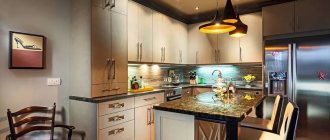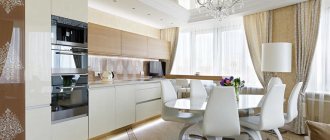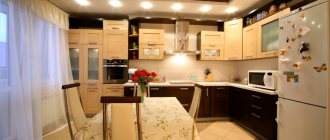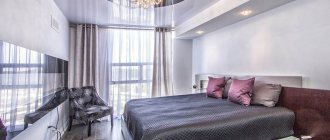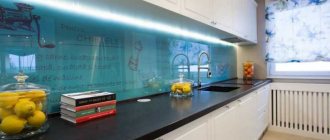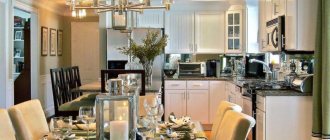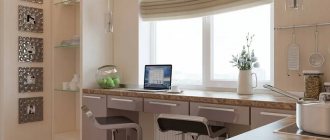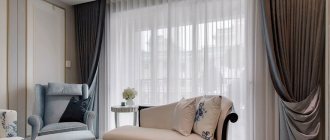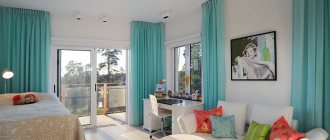The kitchen is a special territory. It simultaneously performs purely utilitarian, practical functions, such as a bathroom or pantry, and is a place of comfortable, spiritual relaxation for the whole family. It’s not for nothing that the kitchen is called the soul, the heart of any home. Even earlier, the hearth, located in the kitchen, was associated with family and the blessing of ancestors. And today we have special feelings for the kitchen. Where are we rushing to share what is sore? Where can you grab a piece of something appetizing and delicious before dinner? What room in the house exudes special comfort and warmth? Of course, all this is the kitchen!
To harmoniously combine different functional areas, to make the kitchen both cozy and convenient for work, a careful approach to artificial lighting is required. It plays a leading role in ensuring comfort in the room. After all, the advantages of the most sophisticated household appliances and magnificent, expensive kitchen units come to naught in dim, insufficient lighting. Moreover, with a lack of light, the safety of people working and in the kitchen suffers, and traumatic situations are created.
How to properly arrange lighting fixtures in the kitchen? Which lamps are suitable? What do you need to know before starting installation? What mistakes are made during the work process? Our specialists will tell you about all this.
General kitchen lighting: how not to mess it up
We have already explained above that 150 lux (lux) is the minimum illumination threshold recommended by the state standard. Accordingly, when organizing general lighting, it is important not to fall below this value, otherwise the kitchen will turn out to be uncomfortable for use.
The central chandelier is still considered the main element in many interiors. However, it is not always convenient: while cooking, you can easily block the light coming from it with your head. Therefore, it is optimal to support it (or replace it) with a couple of additional lamps located exactly in the cooking area and dining area.
Designer tips
Irina Polyakova
founder of the interior studio, architect and interior designer. The main area of work is kitchen design
When drawing up a project, you need to remember that the center of the main chandelier does not coincide with the center of the room at all. For a simple reason - a set located near the wall takes up a certain part of the ceiling. Consider this point if you are prone to perfectionism and any asymmetry irritates you furiously.
Sketch out your room lighting plan on paper. You must clearly know the layout of your kitchen: where the zones are located, how best to organize the network connection. It is at this stage that conflicts can be prevented. For example, when it is not possible to organize the correct outlet for lighting or insert the switch in a convenient place.
If there is little space, then you can refuse large lamps: spots will cope with their function perfectly. In spacious rooms, you can build general lighting according to the classical scheme:
- central chandelier;
- pendant lights above the dining table and countertop;
- spot - around the perimeter.
The most common errors in organization are related to the distribution of light flux between zones. It is necessary to maintain a balance so that the final script does not irritate with its low optimization and does not interfere with cooking and eating.
Location of spotlights
One of the most popular ways to optimize the light flow in the kitchen space. The image below shows almost all options for their location on the ceiling. Note that each spot illuminates approximately 1-1.5 meters around (depending on how many lumens the LED built into it produces).
If you install them around the perimeter, then step back from the wall at least 50 cm. The light from them will evenly pour from the ceiling, despite the upper cabinets of the kitchen unit located below.
Spots can be arranged either according to the laws of symmetry or arbitrarily. The main thing is not to overdo it with the quantity. Otherwise, it will dazzle the eyes - and the level of comfort in the room will noticeably decrease.
If spots in a room serve as accent lighting, it is logical to place them around the light source that bears the overall load.
Spots combine quite harmoniously with track systems. Although, it would seem, with such a neighborhood they might seem superfluous.
You will learn how to choose the right track system and which lamps to go with it in our separate article >>> go.
Work area lighting
This is done using accent lighting: the light is purposefully focused on the countertop and stove to make it convenient to cook.
For this purpose, special halogen or LED lamps are mounted on the base of hanging cabinets. They give a beautiful and harmonious glow, quite sufficient to highlight all the key points of the working area.
Or an RGB strip is stretched along the tabletop, neatly packaged in a plastic profile. Inside it are again LEDs. You can also use the monochrome option. It doesn't brighten up the decor as much, but it does a better job with accent lighting.
The tape can also be mounted at the bottom of the cabinets. It is especially impressive if it is “packed” in a glass panel. The glow is flowing and immediately creates a special atmosphere in the room.
If you want to save money, buy a hood with built-in lighting. Yes, the brightness will not be enough for the entire area, but overall you will get accent lighting of a decent level.
Light over the dining area
The space of options depends primarily on where the dining complex is located - and what parts make up it. Most often this is:
- table;
- chairs;
- sofa;
- bar counter.
If the kitchen configuration allows, it is better to place the table close to the window: so that during the day natural light can easily enter the area as a whole. The lack of lighting in the evening can be compensated for by ceiling chandeliers. They should hang directly above the table to create even accent lighting.
Lamps should not hang too low from the ceiling so as not to cause discomfort while eating. In addition, it is important to choose the correct brightness of the lamp: the lower the lighting fixture hangs, the less lumens it should produce. This way you will avoid situations in which annoying light endlessly blinds your eyes.
In small kitchens, it is best to place a round or square dining table against the wall. The lighting function will be taken over by a sconce suspended at a height of approximately 1.5 meters. Usually they use two symmetrically located copies at once: it looks prettier and both sides of the table are illuminated better.
Spots
Super-functional modern lighting fixtures that can be easily directed to a particular area or object. There are suspended, overhead, built-in ceiling or furniture spots, with industrial, ordinary or sophisticated lampshades. For all this they are valued by designers.
Spots are suitable for huge spaces and kitchens in Khrushchev, and the variety of shapes and models gives them a green light in every interior direction. Decorate the metal crossbar with your own hands, as we advised in the case of the chandelier, and bring the spot closer to soft classic styles.
One such lamp will gently highlight a picture, niche or other accent detail of the interior, and several lamps will illuminate a spacious room.
Spots and spot systems are useful when rearranging furniture, because they will provide the right direction of light for cooking or eating. Examples of spots are waiting for you in the photo.
Interior lighting in cabinets
Incredibly helpful if you need to quickly get something out of the cabinets. And at the same time it serves as decorative lighting, making the atmosphere in the kitchen warmer and more homely.
Formatted in different ways. The simplest one is to cover it with LED strip. There will be little light, but you can adjust the color temperature and create a unique pattern in the room.
Simple, but requiring financial investment - magnetic lamps with a motion sensor. They are attached with double-sided tape and turn on only when you open the door. They are also not very powerful, but they will help you find glasses or cutlery that have gone missing somewhere.
The most difficult, but accessible to everyone, is the installation of spots. They cut directly into the cabinet and connect to the network through a pre-laid channel. You'll have to be smart, but your cabinets will always be light.
Kitchen lamps for various types of ceilings
The choice of lamp depends on individual preferences, estimated budget, resistance to high temperatures and humidity, and type of ceiling covering.
- A traditional painted (whitewashed) ceiling is least suitable for design delights, since it does not have technological space. Its standard types of design are a pendant lamp or a chandelier.
- Gypsum plasterboard ceiling (GVL) is resistant to high temperatures and is attached at a certain distance from the surface of the base. You can place any lamps and lamps on it.
- LED lamps are usually installed on suspended ceilings, which do not create a high degree of heating.
- Slatted ceilings are perfectly combined with any type of lighting fixtures.
Chandelier and built-in lighting in the kitchen Chandelier, wall lamp and built-in lighting in the kitchen Built-in lamps in the kitchen Beautiful yellow chandelier Stained glass chandelier Black and white chandeliers in the kitchen Built-in lamps in kitchen design
Options for beautiful chandeliers in the kitchen
Decorative lighting
Unlike accent lighting, it is not a mandatory element of the kitchen lighting scenario. However, when used skillfully, it emphasizes the advantages of the interior and makes it original and memorable.
If you have a mosaic on your apron, add a three-color or monochrome LED strip to the bottom of the headset. It is flexible, so it can be pulled out easily even with corners. The emitted light will delicately highlight the glass or stone texture, creating a bizarre play of light and penumbra. Stunning intimate setting!
See also: Kitchen apron - 106 fashionable design ideas in real photos
If you stretch an LED strip along the perimeter between the ceiling and the set, you can achieve a useful optical effect of expanding the space. This is a good life hack for owners of modest-sized Khrushchev apartment buildings with very low ceilings.
The lower perimeter is used similarly. Below, the glow creates additional volume: the floor seems to float in space. In addition, this is a very beautiful and original design touch.
Use tape not only on the outside of the cabinets, but also on the inside. We have already written about the usefulness of this step, but here we propose once again to be convinced of the power of the aesthetics it generates.
Choosing types of lighting fixtures
In addition to performing basic functions, lamps must comply with (or at least not contradict) the parameters and general style of the kitchen, the design of the ceiling, create coziness and meet energy consumption requirements.
And here are the lighting devices you have at your disposal:
- pendant - chandeliers, lampshades, spots or just light bulbs on a cord;
- built into the ceiling - spots, panel, modular, spotlights;
- overhead – tablet lamps, spotlights, spots;
- LED Strip Light;
- ceiling-mounted monochrome or RGB lighting.
If you are thinking about decorative lighting for two-level structures, the effect of a floating ceiling and a starry sky would be interesting solutions.
The interior style and size of the kitchen will help you choose the appropriate type of lamp. It is desirable that the lighting fixtures match the decor, are made from the same material and do not differ in color. Similar lampshades can be found from different manufacturers.
Mixing styles is in fashion, so don’t be afraid to go beyond your chosen direction. Lighting should be comfortable, even if it turns a classic interior into a neoclassical one.
Now let's go through each of the points.
Which lamps to choose for the kitchen
We reflected all the available options in the form of a table, where the advantages and disadvantages of each are described in detail.
| Types of lamps | Ratio of power to luminous flux (W - Lm) | Advantages | Flaws |
| Incandescent lamps | 100 — 1200 | cheap | overheat and quickly fail; consume a lot of energy; dim. |
| Luminescent | 30 — 1200 | moderately economical; produce decent brightness; | are more expensive; react to fluctuations in electricity in the network. |
| Halogen | 100 — 1300 | give very beautiful light; increased light output; make up for the lack of sunlight in the room | warming themselves; the spectrum shifts towards cool shades. |
| LED | 15 — 1200 | consume 10 times less electricity; may have different color temperatures; serve for a long time and do not go out during power surges; easily integrated into dimmer systems | expensive |
| Energy saving | 10/12 — 1200 | allow you to save on electricity; long service life. | contains mercury vapor |
Selecting lamps by type, light, color
For the kitchen, experts recommend lamps that imitate neutral white or warm light. The flow temperature is measured in Kelvin. Cold bluish, lifeless white lighting is permissible here only if you have a mini-working office - it can cause anxiety, especially in unbalanced people, and greatly distort the natural color of food, visually making it unappetizing. A warm white option will help you relax, relax with a cup of tea or with your family.
The configuration of the bulb itself can also be different: pear-shaped, candle-shaped, pipe-shaped, spiral-shaped, mushroom-shaped, spot-shaped, etc. LED lamps have the best efficiency, durability, and environmental friendliness, but their prices are relatively high. The cheapest option is ordinary incandescent light bulbs; the price of such a device is minimal, but the electricity consumption to power them is very significant.
Whatever type of lamp is chosen, the light should not be blinding.
LED
LED light bulbs can significantly save your budget, especially if the lamp has a motion sensor built into it, which turns on if someone enters the kitchen, and turns off a few minutes after any activity recorded by the mechanism is stopped. Installing a touch switch system will allow you to adjust the light level.
Incandescent lamps
This type of lamp is used in lamps directed at the ceiling, wall, piece of furniture, and only reflected light is captured by the human eye. Such light bulbs get very hot, so in rooms decorated in black-brown-violet tones that almost completely absorb light, their use is ineffective. In case of close contact with textile, plastic, paper lampshades, there is a high risk of fire. Conventional 40-100 Watt incandescent lamps have a light temperature of 2600-2900 K.
Halogen
This type of design is also an incandescent lamp, but in its manufacture a thin tungsten wire of a certain brand is used, and the flask itself is filled with an oxygen mixture, supplemented with volatile compounds of iodine and bromine. Halogen lamps have a color temperature of 3000-3200 K and last much longer than incandescent lamps, although their sizes are slightly smaller. It is believed that the device produces a luminous flux that is as close as possible to the natural spectrum, reducing visual fatigue. This type of device is divided into four types:
- linear;
- fingered;
- with external flask;
- with reflector.
When installing halogen lamps, specialized transformers are used; it is recommended to wear gloves when replacing a burnt-out device with a new one.
Halogen IRC lamps
The name of the device refers to a lamp with an infrared coating, which is applied to the surface of the bulb during production so that visible light penetrates outward and most of the heat is reflected back. The service life of the light bulb is twice as long, and the energy consumed is much less, which allows for significant financial savings.
Any halogen elements should be kept perfectly clean - in places of minimal contamination, the device quickly burns out and fails.
Luminescent
Such lighting devices are distinguished by smooth warm white light if their color temperature is 2700-3300 K, neutral white at 3400-4500 K, cold daylight at 4600-6500 K. They do not need a special power supply, but only plug into the outlet after fastening in the right place. Fluorescent lamps are divided into two types:
- having the form of long straight, semicircular, U-shaped tubes equipped with an internal ballast;
- energy-saving devices of a conventional form, often equipped with a light sensor.
Both configurations are durable, economical, expensive options shine as brightly as possible from the moment they are turned on, close to natural light, while cheap ones distort the spectrum. The variety of design solutions allows you to choose suitable appliances for the interior of any kitchen.
Lighting Features
The choice of light bulbs based on light temperature directly affects vision and color perception of the interior. Warm colors help you relax, while cold colors are great for toning. A device that completely imitates sunlight has not yet been created, although work in this direction has been going on for a long time.
Correctly organizing kitchen lighting, both primary and additional, can be done using lamps that provide different shades of light output. Experts distinguish three main options:
- warm white – 2500-3500 K;
- white neutral, close to natural – 3600-5000 K;
- cold white – 5100-5600 K.
Various options are acceptable for the dining area of the kitchen: if long gatherings with friends, daily family dinners are held here, warm lighting is recommended, but when the place is intended for quick meals two to three times a day, then it is better to use cool white light bulbs.
The kitchen, the space of which is combined with the living room, is usually illuminated with warm light, which allows you to create the most relaxed atmosphere, especially in combination with a chandelier that gently diffuses the light flux. Warm options are also recommended for interiors designed in “soft” pastel colors - the cold shades of objects here will be blurred, blue, purple, green, gray colors will be slightly distorted.
Natural white leaves all colors practically unchanged, so such devices are mounted above the kitchen work area, and if there are mirrors in the room, around them too, but so that the reflected light does not blind those present.
The cool white hue is similar to the pale winter sun, but is perceived by the human eye as having the highest intensity. It is most convenient to use in combination with natural lighting, if it is insufficient. Cold accent lighting is used to highlight some decorative elements, divide the space into zones, and create a light border between the kitchen and the room adjacent to it.
Options for the kitchen-living room
The kitchen-living room, due to its size, requires maximum elaboration of this issue: it is necessary to organize the light flux in such a way that it is safely sufficient in all areas of the room.
To do this, a scenario of 3 lighting levels is created. The central chandelier takes on the overall role. If the configuration does not allow it to be correctly integrated into the project, it is quite logical to create an ensemble of several chandeliers and place them in the center of the ceiling. The glow should not be too bright and intrusive; it is better to prefer warmer or neutral options to avoid the effect of a hospital environment.
You will find the most beautiful interiors of a kitchen-living room of 20 sq m here.
An alternative, and more modern option is to simply divide the kitchen into 2 parts, placing a chandelier in each. Should we make them the same? Optionally, decide strictly on the interior design in different areas of the room.
Accent lighting is provided by linear spots surrounding the perimeter of the kitchen unit. Such zone lighting will help you prepare food comfortably and easily find all the necessary items in the cabinets.
You can also select a recreation area. For example, a cool multi-level ceiling with built-in lighting on tires. This way you can adjust the lighting angle, and if the lamps are dimmer, then you can completely adjust the color temperature to suit you.
Light in a small kitchen
It is the luminous flux, adjusted to the smallest detail, that can become the lifesaver that will save your tiny kitchen from despondency and forever make it friends with harmony and comfort.
You can always display a powerful chandelier with one large shade. It will provide decent illumination in the center - this is a plus. At the same time, the corners can be darkened - and this is a serious disadvantage. Point light sources or track systems will help correct the balance. They should be used for zone lighting: the work area, the sink, the set as a whole.
110 best small kitchen design ideas + a complete design guide can be found here.
Often, if there is a lack of usable space, it is possible to build general lighting solely on the basis of spots. Select them at the rate of 1 piece. by 1.5 sq. meters. But how to arrange it gives you complete freedom for your design inspiration.
Designer tips
Irina Polyakova
founder of the interior studio, architect and interior designer. The main area of work is kitchen design
There is an unspoken rule - to outline the contours of the kitchen set installed in the kitchen with spots. Most often in small kitchens they are either straight or angular, so a symmetrical linear construction will be required.
When developing a kitchen design project, give preference to light colors when decorating walls and selecting furniture. Still, they reflect light better, and this will greatly facilitate your task of creating a cozy atmosphere in the room.
Lamps should not hang very low from the ceiling. This visually reduces the height of an already small room. And too bright light in the immediate vicinity of the head blinds the eyes and does not add comfort.
Types of kitchen lighting.
But first, let’s answer the question, why do you need additional lighting in the kitchen?! First of all, this is necessary to make housewives much more comfortable cooking in the evening. Additional lighting will illuminate all corners of the kitchen unit, including its countertop. But when choosing lighting strips, it is important to give preference to moderately bright LEDs, otherwise the light will “hit” your eyes, thereby turning a comfortable time in the kitchen into real torture. It has long been proven that the most comfortable glow from the point of view of human perception is considered to be diffused light emanating from several lighting devices at once.
It is also impossible not to note the decorative part of using additional light; the fact is that cabinets in the kitchen can be illuminated solely to create a unique effect. Moreover, on sale you can find ribbons of completely different colors, ranging from red light to blue light. With such a variety, literally everyone can find the right shade for their kitchen.
